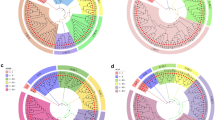Summary
This paper describes the use of oligonucleotide probes to reveal highly polymorphic DNA regions in pomato. With a (GATA)4 probe the level of polymorphism detected is high enough to identify all 15 tomato cultivars used in this study. Individual plants of one cultivar all showed the same cultivar-specific DNA-finger-print. In an F2-population of self-fertilized cv. Sonatine, GATA-containing loci segregated in a Mendelian (3∶1) fashion. Experiments with in-vitro propagated plant material showed that the DNA-fingerprints are not affected by tissue-culture procedures. This indicates that changes in the genetic integrity, which often accompany in-vitro propagation (somaclonal variation), are not extended to the DNA detected with the (GATA)4 probe. The relative high stability and the Mendelian segregation of (GATA)4-derived DNA-fingerprints make them ideally suited for identification of tomato cultivars.
Similar content being viewed by others
References
Bernatzky R, Tanksley SD (1986) Genetics of actin-related sequences in tomato. Theor Appl Genet 72:314–321
Buitenkamp J, Ammer H, Geldermann H (1991) DNA-fingerprinting in domestic animals. Electrophoresis 12:169–174
Dallas JF (1988) Detection of DNA “fingerprints” of cultivated rice by hybridization with a human minisatellite DNA probe. Proc Natl Acad Sci USA 85:6831–6835
Dellaporte SL, Wood J, Hicks JB (1983) A plant molecular DNA minipreparation. Version II. Plant Mol Biol Rep 1:19–21
Epplen JT (1988) On simple repeated GAT/CA sequences in animal genomes: A critical reappraisel. J Heredity 79:409–417
Gill P, Jeffreys AJ, Werrett DJ (1985) Forensic application of DNA-fingerprints. Nature 318:577–579
Jeffreys AJ, Wilson V, Thein SL (1985) Hypervariable “minisatellite” regions in human DNA. Nature 314:67–73
Karp A (1991) On the current understanding of somaclonal variation. Oxford Surv Plant Mol Cell Biol 7:1–58
Kuhnlein U, Dawe Y, Zadworny D, Gavora JS (1989) DNA-fingerprinting: a tool for determining genetic distances between strains of poultry. Theor Appl Genet 77:669–672
Messeguer R, Ganal MW, Steffens JC, Tanksley SD (1991) Characterization of the level, target sites and inheritance of cytosine methylation in tomato nuclear DNA. Plant Mol Biol 16:753–770
Miller JC, Tanksley SD (1990) RFLP analysis of phylogenetic relationships and genetic variation in the genus Lycopersicon. Theor Appl Genet 80:437–448
Murashige T, Skoog F (1962) A revised medium for rapid growth and bioassays with tobacco tissue cultures. Physiol Plant 15:473–497
Nakamura Y, Leppert M, O'Connell P, Wolff R, Holm T, Culver M, Martin C, Fujimoto E, Hoff M, Kumlin E, White R (1987) Variable number of tandem repeat (VNTR) markers for human gene mapping. Science 235:1616–1622
Nanda I, Zischler H, Epplen C, Guttenbach M, Schmid M (1991) Chromosomal organization of simple repeated DNA sequences used for DNA-fingerprinting. Electrophoresis 12:193–203
Nürnberg P, Barth I, Fuhrmann E, Lenzner C, Losanova T, Peters C, Pöche H, Thiel G (1991) Monitoring genomic alterations with a panel of oligonucleotide probes specific for various simple repeat motifs. Electrophoresis 12:186–192
Sambrook J, Fritsch EF, Maniatis T (1989) Molecular cloning: a laboratory manual. 2nd edn. Cold Spring Harbor Laboratory, Cold Spring Harbor, New York
Tautz D (1989) Hypervariability of simple sequences as a general source for polymorphic DNA markers. Nucleic Acids Res 17:6463–6471
Tautz D, Renz M (1984) Simple sequences are ubiquitous repetitive components of eukaryotic genomes. Nucleic Acids Res 12:4127–4138
Tzuri G, Hillel J, Lavi U, Haberfeld A, Vainstein A (1991) DNA-fingerprint analysis of ornamental plants. Plant Sci 76:91–97
Van den Bulk RW, Löffler HJM, Lindhout WH, Koornneef M (1990) Somaclonal variation in tomato: effect of explant source and comparison with chemical mutagenesis. Theor Appl Genet 80:817–825
Van der Beek H, Verkerk R, Zabel P, Lindhout P (1992) Mapping strategy for resistance genes in tomato based on RFLPs between cultivars: CF9 (resistance to Cladosporium fulvum) on chromosome 1. Theor Appl Genet 84:106–112
Van Houten WHJ, Van Heusden AW, Van der Voort JR, Raijmann L, Bachmann K (1991) Hypervariable DNA-fingerprint loci in Microseris-Pygmaea (Asteraceae, Lactuceae). Bot Acta 104:252–256
Weising K, Weigand F, Driesel AJ, Kahl G, Zischler H, Epplen JT (1989) Polymorphic simple GATA/GACA repeats in plant genomes. Nucleic Acids Res 17:10128
Weising K, Beyermann B, Ramser J, Kahl G (1991) Plant DNAfingerprinting with radioactive and digoxygenated oligonucleotide probes complementary to simple repetitive DNA sequences. Electrophoresis 12:159–169
Author information
Authors and Affiliations
Additional information
Communicated by F. Salamini
Rights and permissions
About this article
Cite this article
Vosman, B., Arens, P., Rus-Kortekaas, W. et al. Identification of highly polymorphic DNA regions in tomato. Theoret. Appl. Genetics 85, 239–244 (1992). https://doi.org/10.1007/BF00222865
Received:
Accepted:
Issue Date:
DOI: https://doi.org/10.1007/BF00222865




